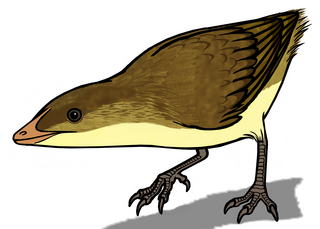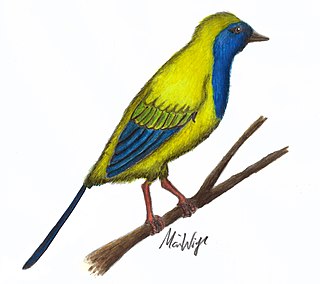
Archaeopteryx, sometimes referred to by its German name, "Urvogel", is a genus of avian dinosaurs. The name derives from the ancient Greek ἀρχαῖος (archaīos), meaning "ancient", and πτέρυξ (ptéryx), meaning "feather" or "wing". Between the late 19th century and the early 21st century, Archaeopteryx was generally accepted by palaeontologists and popular reference books as the oldest-known bird. Older potential avialans have since been identified, including Anchiornis, Xiaotingia, and Aurornis.

Dinosaurs are a diverse group of reptiles of the clade Dinosauria. They first appeared during the Triassic period, between 243 and 233.23 million years ago (mya), although the exact origin and timing of the evolution of dinosaurs is a subject of active research. They became the dominant terrestrial vertebrates after the Triassic–Jurassic extinction event 201.3 mya and their dominance continued throughout the Jurassic and Cretaceous periods. The fossil record shows that birds are feathered dinosaurs, having evolved from earlier theropods during the Late Jurassic epoch, and are the only dinosaur lineage known to have survived the Cretaceous–Paleogene extinction event approximately 66 mya. Dinosaurs can therefore be divided into avian dinosaurs—birds—and the extinct non-avian dinosaurs, which are all dinosaurs other than birds.

Caudipteryx is a genus of small oviraptorosaur dinosaurs that lived in Asia during the Early Cretaceous, around 124.6 million years ago. They were feathered and extremely birdlike in their overall appearance, to the point that some paleontologists sugegsted it was a bird. Two species have been described: C. zoui, in 1998, and C. dongi, in 2000.

Confuciusornis is a genus of basal crow-sized avialan from the Early Cretaceous Period of the Yixian and Jiufotang Formations of China, dating from 125 to 120 million years ago. Like modern birds, Confuciusornis had a toothless beak, but closer and later relatives of modern birds such as Hesperornis and Ichthyornis were toothed, indicating that the loss of teeth occurred convergently in Confuciusornis and living birds. It was thought to be the oldest known bird to have a beak, though this title now belongs to an earlier relative Eoconfuciusornis. It was named after the Chinese moral philosopher Confucius. Confuciusornis is one of the most abundant vertebrates found in the Yixian Formation, and several hundred complete specimens have been found.

Ornithomimosauria are theropod dinosaurs which bore a superficial resemblance to the modern-day ostrich. They were fast, omnivorous or herbivorous dinosaurs from the Cretaceous Period of Laurasia, as well as Africa and possibly Australia. The group first appeared in the Early Cretaceous and persisted until the Late Cretaceous. Primitive members of the group include Nqwebasaurus, Pelecanimimus, Shenzhousaurus, Hexing and Deinocheirus, the arms of which reached 2.4 m (8 feet) in length. More advanced species, members of the family Ornithomimidae, include Gallimimus, Struthiomimus, and Ornithomimus. Some paleontologists, like Paul Sereno, consider the enigmatic alvarezsaurids to be close relatives of the ornithomimosaurs and place them together in the superfamily Ornithomimoidea.

Alvarezsaurus is a genus of alvarezsaurid dinosaur from the Late Cretaceous, living in Argentina approximately 86 - 83 million years ago. It was a small dinosaur, measuring 1–1.4 m (3.3–4.6 ft) long and weighing approximately 3 kg (6.6 lb). It was found in the Bajo de la Carpa Formation and was named by paleontologist José Bonaparte in 1991 after the historian Don Gregorio Alvarez. The type species is A. calvoi.

The evolution of birds began in the Jurassic Period, with the earliest birds derived from a clade of theropod dinosaurs named Paraves. Birds are categorized as a biological class, Aves. For more than a century, the small theropod dinosaur Archaeopteryx lithographica from the Late Jurassic period was considered to have been the earliest bird. Modern phylogenies place birds in the dinosaur clade Theropoda. According to the current consensus, Aves and a sister group, the order Crocodilia, together are the sole living members of an unranked reptile clade, the Archosauria. Four distinct lineages of bird survived the Cretaceous–Paleogene extinction event 66 million years ago, giving rise to ostriches and relatives (Palaeognathae), waterfowl (Anseriformes), ground-living fowl (Galliformes), and "modern birds" (Neoaves).

The scientific question of within which larger group of animals birds evolved has traditionally been called the "origin of birds". The present scientific consensus is that birds are a group of maniraptoran theropod dinosaurs that originated during the Mesozoic Era.

Eoalulavis is a monotypic genus of enantiornithean bird that lived during the Barremian, in the Lower Cretaceous around 125 million years ago. The only known species is Eoalulavis hoyasi.

Liaoxiornis is a dubious genus of enantiornithine bird. The only named species is Liaoxiornis delicatus, described by Hou and Chen in 1999. Because the species was named for a hatchling specimen, it cannot be matched with adult specimens, and so it is impossible to determine which, if any, birds from the same rocks represent adults of this species. Luis Chiappe and colleagues therefore regarded it as a nomen vanum or at least a nomen dubium, and recommended that use of the name be abandoned.
Noguerornis is a genus of enantiornithine bird possibly related to Iberomesornis. It lived during the Early Cretaceous about 130 mya and is known from fossils found in the La Pedrera de Rúbies Formation at El Montsec, Spain.
Neuquenornis volans is a species of enantiornithean birds which lived during the late Cretaceous period in today's Patagonia, Argentina. It is the only known species of the genus Neuquenornis. Its fossils were found in the Santonian Bajo de la Carpa Formation, dating from about 85-83 million years ago. This was a sizeable bird for its time, with a tarsometatarsus 46.8mm long. Informal estimates suggest that it measured nearly 30 cm (12 in) in length excluding the tail.

Yixianornis is a bird genus from the early Cretaceous period. Its remains have been found in the Jiufotang Formation at Chaoyang dated to the early Aptian age, around 120 million years ago. Only one species, Yixianornis grabaui, is known at present. The specific name, grabaui, is named after American paleontologist Amadeus William Grabau, who surveyed China in the early 20th century.
Paleontology or palaeontology is the study of prehistoric life forms on Earth through the examination of plant and animal fossils. This includes the study of body fossils, tracks (ichnites), burrows, cast-off parts, fossilised feces (coprolites), palynomorphs and chemical residues. Because humans have encountered fossils for millennia, paleontology has a long history both before and after becoming formalized as a science. This article records significant discoveries and events related to paleontology that occurred or were published in the year 2002.

Protopteryx is an extinct bird and the most basal enantiornithean, from the Cretaceous period. The type species is P. fengningensis. It was first discovered in the Sichakou Member of the Yixian Formation or Huajiying Formation of Hebei Province, northern China, dating from 131 Ma ago. Protopteryx has been found in the Daibeigou formation, as well. The name Protopteryx means "primitive feather": "proto-" meaning "the first of" and "-pteryx" meaning "feather" or "wing." The name comes from the fact that Protopteryx feathers are more primitive than those of modern birds, such as the two elongated tail feathers that lack barbs and rami.

The La Pedrera de Rúbies Formation is an Early Cretaceous (late Berriasian to early Barremian geologic formation in Catalonia, Spain. The formation crops out in the area of the Montsec in the Organyà Basin. At the La Pedrera de Meià locality, the formation consists of rhythmically laminated, lithographic limestones that formed in the distal areas of a large, shallow coastal lake. It is noted for the exceptional preservation of articulated small vertebrates and insects, similar to that of the Solnhofen Limestone.
Praeornis is a dubious genus of early avialan or bird-like dinosaur, named on the basis of a single feather discovered in the Karabastau Formation of Kazakhstan by Sharov in 1971. A second specimen was discovered in 2010 by Dzik et al. The feathers of Praeornis likely represent modified tail feathers used for display or balance, similar to those found in some other early avialans. The feathers of Praeornis are unique thanks to their extremely thick central quill (rachis) and stiffened barbs.
Gareth John Dyke is a paleontologist whose work is concerned with the evolutionary history of birds and their dinosaurian relatives. His specific research interests include the phylogenetics of birds, the functional morphology of aves and non-avian dinosaurs, as well as the paleoenvironments of fossil vertebrates.

Changyuraptor is a genus of "four-winged", predatory dinosaurs. It is known from a single fossil specimen representing the species Changyuraptor yangi, which was discovered from Early Cretaceous deposits in Liaoning Province, China. C. yangi belongs to the group of dromaeosaurid theropod dinosaurs called the Microraptoria.













